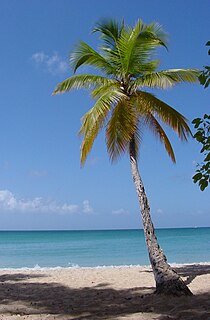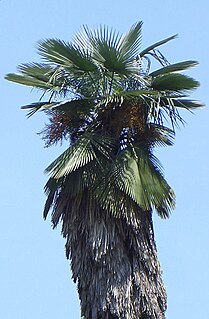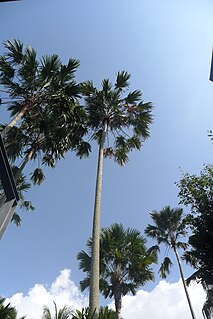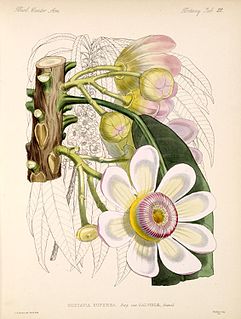
The Arecaceae is a family of perennial flowering plants in the monocot order Arecales. Their growth form can be climbers, shrubs, tree-like and stemless plants, all commonly known as palms. Those having a tree-like form are called palm trees. Currently 181 genera with around 2,600 species are known, most of them restricted to tropical and subtropical climates. Most palms are distinguished by their large, compound, evergreen leaves, known as fronds, arranged at the top of an unbranched stem. However, palms exhibit an enormous diversity in physical characteristics and inhabit nearly every type of habitat within their range, from rainforests to deserts.

Liriodendron is a genus of two species of characteristically large trees, deciduous over most of their populations, in the magnolia family (Magnoliaceae).

Robinia pseudoacacia, commonly known in its native territory as black locust, is a medium-sized hardwood deciduous tree, belonging to the tribe Robinieae of the legume family Fabaceae. It is endemic to a few small areas of the United States, but it has been widely planted and naturalized elsewhere in temperate North America, Europe, Southern Africa and Asia and is considered an invasive species in some areas. Another common name is false acacia, a literal translation of the specific name.

Trachycarpus is a genus of eleven species of palms native to Asia, from the Himalaya east to eastern China. They are fan palms, with the leaves with a bare petiole terminating in a rounded fan of numerous leaflets. The leaf bases produce persistent fibres that often give the trunk a characteristic hairy appearance. All species are dioecious, with male and female flowers produced on separate plants although female plants will sometimes produce male flowers, allowing occasional self-pollination.

Trachycarpus fortunei, the Chinese windmill palm, windmill palm or Chusan palm, is a species of hardy evergreen palm tree in the family Arecaceae, native to parts of China, Japan, Myanmar and India.

Chamaerops is a genus of flowering plants in the family Arecaceae. The only currently fully accepted species is Chamaerops humilis, variously called European fan palm or the Mediterranean dwarf palm. It is one of the most cold-hardy palms and is used in landscaping in temperate climates.

Roystonea is a genus of eleven species of monoecious palms, native to the Caribbean Islands, and the adjacent coasts of the United States (Florida), Central America and northern South America. Commonly known as the royal palms, the genus was named after Roy Stone, a U.S. Army engineer. It contains some of the most recognizable and commonly cultivated palms in tropical and subtropical regions.

Beaucarnea recurvata, the elephant's foot or ponytail palm, is a species of plant in the family Asparagaceae. The species was native to numerous states of eastern Mexico but is now confined to the state of Veracruz. Despite its common name, it is not closely related to the true palms (Arecaceae). It has become popular in Europe and worldwide as an ornamental plant. There are 350-year-old Beaucarneas registered in Mexico.

Ulmus alata, the winged elm or wahoo, is a small- to medium-sized deciduous tree endemic to the woodlands of the southeastern and south-central United States. The species is tolerant of a wide range of soils, and of ponding, but is the least shade-tolerant of the North American elms. Its growth rate is often very slow, the trunk increasing in diameter by less than 5 mm per year. The tree is occasionally considered a nuisance as it readily invades old fields, forest clearings, and rangelands, proving particularly difficult to eradicate with herbicides.

Trachycarpus takil, the Kumaon palm, is a fan palm tree that is endemic to the foothills of the Himalaya in southern Asia.

Saribus rotundifolius, also known as the footstool palm, is a common fan palm found in Southeast Asia. It is a member of the genus Saribus.

Sabal bermudana, commonly known as the Bermuda palmetto or bibby-tree, is one of 15 species of palm trees in the genus Sabal and is endemic to Bermuda although reportedly naturalized in the Leeward Islands. It was greatly affected by the introduction of non-native plants such as the Chinese fan palm, which created competition for space that it usually lost.

Phoenix sylvestris also known as silver date palm, Indian date, sugar date palm or wild date palm, is a species of flowering plant in the palm family native to southern Pakistan, most of India, Sri Lanka, Nepal, Bhutan, Myanmar and Bangladesh. It is also reportedly naturalized in Mauritius, the Chagos Archipelago, Puerto Rico and the Leeward Islands. Growing in plains and scrubland up to 1300 m above sea level, the fruit from this palm species is used to make wine and jelly. The sap is tapped and drunk fresh or fermented into toddy. The fresh sap is boiled to make palm jaggery in West Bengal state of India and Bangladesh.

Gustavia superba is an understory tree that grows in Central and north-western South America. Common names include membrillo, sachamango and heaven lotus. The trunk is around 5-10m high with the leaves radiating from the top.

Trachycarpus martianus is a species in the genus Trachycarpus from two distinct populations, one at 1,500 m (4,900 ft) in the Khasia Hills, Meghalaya Province, in northeast India, the other at 2,400 m (7,900 ft) in central northern Nepal. Other populations have been reported in Assam, Sikkim, Burma and southern China. The main identifying characteristics are the regular leaf splits, the coffee bean shaped seeds and the bare, as opposed to fibrous trunk. The new leaf spear and edges of the petioles are covered with a white tomentum.

Roystonea regia, commonly known as the Cuban royal palm or Florida royal palm, is a species of palm that is native to Mexico, parts of Central America and the Caribbean, and southern Florida. A large and attractive palm, it has been planted throughout the tropics and subtropics as an ornamental tree. Although it is sometimes called R. elata, the conserved name R. regia is now the correct name for the species. The royal palm reaches heights from 50 to over 80 feet tall. Populations in Cuba and Florida were long seen as separate species, but are now considered to belong to a single species.

Butia yatay, the jelly palm or yatay palm, is a Butia palm native to southern Brazil, Uruguay and northern Argentina. It is known as the butiá-jataí in Portuguese in the south of Brazil, as well as simply jataí or butiá. It is sometimes cultivated as an ornamental in Europe and the United States. It is the tallest of all the species in the genus Butia. The fruit is edible with a sweet flavour.

Cycas rumphii, commonly known as queen sago or the queen sago palm, is a dioecious gymnosperm, a species of cycad in the genus Cycas native to Indonesia, New Guinea and Christmas Island. Although palm-like in appearance, it is not a palm.
Trachycarpus oreophilus, also known as Thai mountain fan palm, is a plant species in the genus Trachycarpus. It is known from two distinct populations, one in northwest Thailand, the other in Manipur in northeastern India. The Manipur population was formerly considered a separate species.















